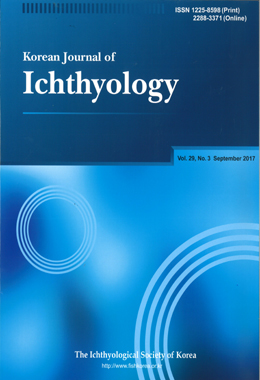한국고유종 동방종개 Iksookimia yongdokensis의 행동주기와 섭식생태를 밝히기 위해 2015년부터 2016년까지 경상북도 축산천과 곡강천에서 조사를 실시하였다. 동방종개는 수온이 10°C 이상 되는 3월부터 11월까지 돌과 자갈, 모래 바닥에서 나와 활동하였지만, 10°C 이하가 되는 12월부터 이듬해 2월까지는 기질 속으로 파고 들어가 월동하였다. 하루 중에는 오전 9시부터 오후 15시까지 활발한 활동과 높은 섭식량을 보였다. 동방종개는 주로 돌 표면이나 돌 틈, 모래 표층에서 여과섭식을 하였다. 소화관 내용물을 상대중요성지수 (IRI)로 분석한 결과, 깔다구과 (Chironomidae, 54.7%)와 새각목 (Branchiopoda, 10.1%), 윤충강 (Rotatoria, 8.7%), 꽃병벌레과 (Arcellidae, 8.6%), 녹조강 (Chlorophyceae, 6.5%), 규조강(Bacillariophyceae, 5.1%) 등의 순서로 높게 나타났다. 당년생치어는 먹이 크기가 작은 윤충강과 새각목, 꽃병벌레과 등을 많이 섭식하였으나 성장하면서 먹이 크기가 큰 깔다구과와 하루살이목 (Ephemeroptera)을 주로 섭식하여 먹이전환을 보였다.
The activity period and feeding ecology of the Iksookimia yongdokensis were investigated to obtain baseline data for its ecological characteristics in the Chuksan Stream and Gokgang Stream, Gyeongsangbuk-do, Korea from 2015 to 2016. I. yongdokensis were active on cobble, pebble and sand bottom from March to November when the water temperature exceeded 10°C, but tended to overwinter in cobble and pebble during the winter months (December~February) when the water temperature was lower than 10°C. During the day from 9 am to 15 pm, individuals of I. yongdokensis were highly active with a high rate of food consumption. I. yongdokensis activley fed on the surface of stone, pebble and sand as a filter feeder. Their main food sources analyzed with an index of relative importance (IRI) include Chironomidae (54.7%), Branchiopoda (10.1%), Rotatoria (8.7%), Arcellidae (8.6%), Chlorophyceae (6.5%) and Bacillariophyceae (5.1%). Juveniles of I. yongdokensis (total length 20~39 mm) fed on small-sized preys such as Rotatoria, Branchiopoda and Arcellidae, but they exhibited a transition in their prey-size markedly dominated by large-sized preys such as Chironomidae and Ephemeroptera as they grow.




